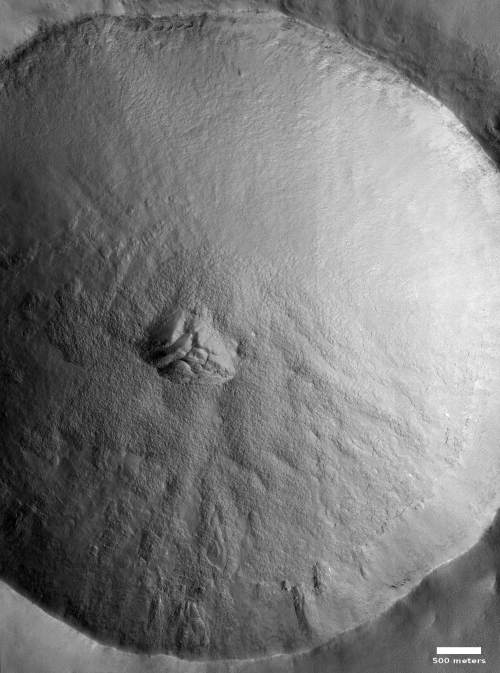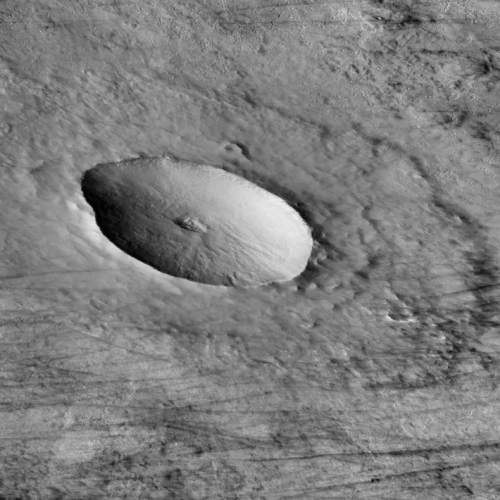Hot spot in northern Martian crater?
Cool image time! The photo to the right, rotated, cropped, and reduced to post here, was taken on September 22, 2021 by the high resolution camera on Mars Reconnaissance Orbiter (MRO). It shows an unnamed four-mile-wide crater in the high northern lowland plains of Mars, at 60 degrees north latitude.
At 60 degrees latitude, it is likely that the crater’s interior is filled with buried glacial ice. A close look at the crater’s interior rim shows that whatever material fills the crater does not quite reach the rim. Furthermore, there are areas in the interior where it appears some slight sublimation has occurred. These features suggest the interior material is buried ice, but do not prove it.
What makes this crater intriguing however is the irregular depression at its center. When craters have a feature at the center, it usually is a central peak, caused at impact. The impact makes the ground act like a pond of water when you drop a pebble into it, with circular ripples (the crater rim) spreading outward and an uplift in the center (the central peak). In the case of a crater, the pond quickly freezes, locking those ripples and uplift in place.
Why a central depression then?
The wider context MRO context camera image of the crater to the right might help explain this. Unlike most MRO photos, this image is an oblique one, looking sideways to the north. The splatter apron around the crater strengthens the hypothesis that there is a lot of near-surface ice at this high latitude, both inside, outside, and under the crater.
So why the central depression? My totally uneducated and very likely incorrect guess is that there is a hot spot spot where that central peak is located but buried under ice. The heat has caused the ice to sublimate away above, causing the depression.
Another possibility is that the depression reflects the topography of the ground below. Small craters like this usually do not have a central peak. Maybe when the impact happened there was further melt in the center, leaving a sinkhole?
All wild guesses. I really have no idea.
Note that the parallel east-west dark streaks in this context camera image are likely dust devil tracks, indicating the prevailing wind direction in this region.
On Christmas Eve 1968 three Americans became the first humans to visit another world. What they did to celebrate was unexpected and profound, and will be remembered throughout all human history. Genesis: the Story of Apollo 8, Robert Zimmerman's classic history of humanity's first journey to another world, tells that story, and it is now available as both an ebook and an audiobook, both with a foreword by Valerie Anders and a new introduction by Robert Zimmerman.
The print edition can be purchased at Amazon or from any other book seller. If you want an autographed copy the price is $60 for the hardback and $45 for the paperback, plus $8 shipping for each. Go here for purchasing details. The ebook is available everywhere for $5.99 (before discount) at amazon, or direct from my ebook publisher, ebookit. If you buy it from ebookit you don't support the big tech companies and the author gets a bigger cut much sooner.
The audiobook is also available at all these vendors, and is also free with a 30-day trial membership to Audible.
"Not simply about one mission, [Genesis] is also the history of America's quest for the moon... Zimmerman has done a masterful job of tying disparate events together into a solid account of one of America's greatest human triumphs."--San Antonio Express-News
Cool image time! The photo to the right, rotated, cropped, and reduced to post here, was taken on September 22, 2021 by the high resolution camera on Mars Reconnaissance Orbiter (MRO). It shows an unnamed four-mile-wide crater in the high northern lowland plains of Mars, at 60 degrees north latitude.
At 60 degrees latitude, it is likely that the crater’s interior is filled with buried glacial ice. A close look at the crater’s interior rim shows that whatever material fills the crater does not quite reach the rim. Furthermore, there are areas in the interior where it appears some slight sublimation has occurred. These features suggest the interior material is buried ice, but do not prove it.
What makes this crater intriguing however is the irregular depression at its center. When craters have a feature at the center, it usually is a central peak, caused at impact. The impact makes the ground act like a pond of water when you drop a pebble into it, with circular ripples (the crater rim) spreading outward and an uplift in the center (the central peak). In the case of a crater, the pond quickly freezes, locking those ripples and uplift in place.
Why a central depression then?
The wider context MRO context camera image of the crater to the right might help explain this. Unlike most MRO photos, this image is an oblique one, looking sideways to the north. The splatter apron around the crater strengthens the hypothesis that there is a lot of near-surface ice at this high latitude, both inside, outside, and under the crater.
So why the central depression? My totally uneducated and very likely incorrect guess is that there is a hot spot spot where that central peak is located but buried under ice. The heat has caused the ice to sublimate away above, causing the depression.
Another possibility is that the depression reflects the topography of the ground below. Small craters like this usually do not have a central peak. Maybe when the impact happened there was further melt in the center, leaving a sinkhole?
All wild guesses. I really have no idea.
Note that the parallel east-west dark streaks in this context camera image are likely dust devil tracks, indicating the prevailing wind direction in this region.
On Christmas Eve 1968 three Americans became the first humans to visit another world. What they did to celebrate was unexpected and profound, and will be remembered throughout all human history. Genesis: the Story of Apollo 8, Robert Zimmerman's classic history of humanity's first journey to another world, tells that story, and it is now available as both an ebook and an audiobook, both with a foreword by Valerie Anders and a new introduction by Robert Zimmerman.
The print edition can be purchased at Amazon or from any other book seller. If you want an autographed copy the price is $60 for the hardback and $45 for the paperback, plus $8 shipping for each. Go here for purchasing details. The ebook is available everywhere for $5.99 (before discount) at amazon, or direct from my ebook publisher, ebookit. If you buy it from ebookit you don't support the big tech companies and the author gets a bigger cut much sooner.
The audiobook is also available at all these vendors, and is also free with a 30-day trial membership to Audible.
"Not simply about one mission, [Genesis] is also the history of America's quest for the moon... Zimmerman has done a masterful job of tying disparate events together into a solid account of one of America's greatest human triumphs."--San Antonio Express-News




That was taken on my 55th birthday.
Looking at the oblique photo, and with the amount of ice likely present, my first impression was ‘Sploosh!’
Jeff-
very cool! (it was a simpler time, eh?!)
Blair–
Hunga Tonga volcano eruption
January 15, 2022
https://youtu.be/v_9FZLwlxTw
1:02
Wayne: Holy Shmazackral! Thanks, and another demonstration of the power of the natural world.
‘You want to see some climate change? Check this out!’ Every large volcano, ever.
My wife snickered at this. Not sure why.
I think you are spot on Bob. The small craters surrounding this all seem very deep and have no evidence of ejecta.
Even if the reason is not buried ice, the ground here is very unusual.
A great find!
Actually, I take back my previous statement regarding ejecta…. Just over halfway “north” on the bigger picture, “splat” ……
Sippin-Bourbon – My inner 14 rear old male was laughing when I saw this